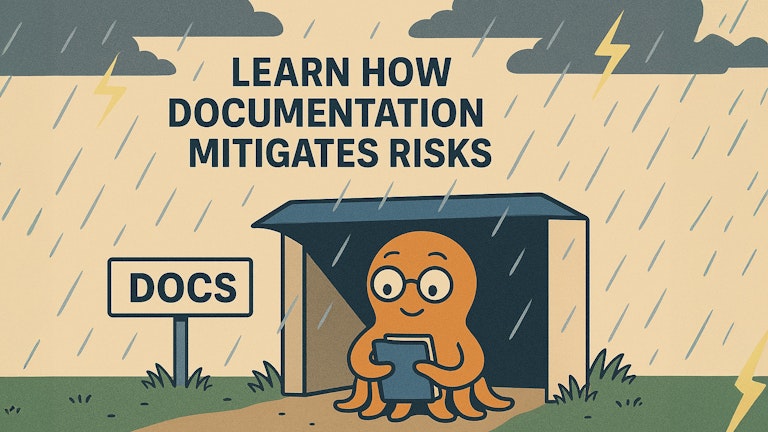Making a business case for documentation, post 6 — Learn how documentation mitigates risks
 Ravi Murugesan —
Ravi Murugesan —  Lana Novikova
Lana Novikova This is the sixth post in a series about making a business case for documentation. We discuss how documentation helps mitigate business risks.

In the previous posts, we covered two of the major business benefits of good documentation: increasing revenue and reducing costs. Here, we’ll look at how documentation can also mitigate risks, such as knowledge loss or fulfilling the legal obligations. Risk mitigation is vital to the long-term success and sustainability of a business. Although it may not always have a direct monetary value, it prevents financial and reputational losses.
Mitigating key knowledge loss
Documentation is crucial in mitigating the so-called bus factor risk, where a project heavily relies on a few experts. By ensuring that critical information about how a product works is accessible to the entire team, documentation safeguards against disruptions caused by the loss of key team members. This reduces the risk of a project stalling due to the sudden unavailability of key team members, thereby maintaining operational continuity and stability.
For instance, teams with quality documentation are 3.8 times more likely to implement security practices (State of DevOps 2021, Google Cloud), indicating their role in ensuring continuity and mitigating risk in team operations.
Fulfilling the legal obligations
Certain industries and businesses are legally obligated to maintain comprehensive documentation. This includes certifications, licensing requirements, and adherence to specific standards. Documentation becomes crucial during pre-initial public offering (stock launch) due diligence, providing transparency and assurance to investors and stakeholders about the legal compliance and robustness of the business operations.
Driving product improvements and increasing base quality
Writing documentation involves testing the application and detecting usability issues, which helps shape the product itself. Through the documentation process, technical writers and developers can identify gaps, inconsistencies, and areas for improvement. This iterative process ensures that the product is continually refined and enhanced based on real-world usage and feedback. Highlighting this point demonstrates the direct impact of quality documentation on product development and user experience, making it a strong business case for investing in comprehensive documentation practices.
Sharing knowledge and fostering collaboration
Documentation can serve as a knowledge map for your product. By using documentation as a support tool and contributing to it, users learn about the application from their own perspective. Moreover, documentation often serves as a catalyst for collaboration within and across teams, offering a centralized knowledge repository that promotes transparency and alignment. By encouraging contributions and engagement, organizations can leverage the collective expertise of their teams to improve processes, drive innovation, and enhance productivity.
An illustration of this point: according to The State of Business Communication by Grammarly, business leaders estimate their teams lose an average of 7.47 hours per week to poor communication, including missing documentation and knowledge base articles.
Let’s do a quick recap of the posts in this series. Posts 1 to 3 laid the foundation: what is good documentation and how it is linked to a company’s goals. Posts 4 to 6 covered some of the important benefits of good documentation: increasing revenue, increasing website traffic, reducing costs, and mitigating risks. Now it’s time to put all this together in the form of a business case document — that’s the topic of the next post.
Text of article ©2025 Ravi Murugesan, Lana Novikova
Released under Creative Commons Attribution 4.0 International (CC BY 4.0)